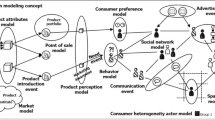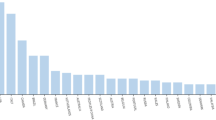Abstract
This paper explores the treatment of intelligent agents as innovations. Past writings in the area of intelligent agents focus on the technical merits and internal workings of agent-based solutions. By adopting a perspective on agents from an innovations point of view, a new and novel description of agents is put forth in terms of their degrees of innovativeness, competitive implications, and perceived characteristics. To facilitate this description, a series of innovation-based theoretical models are utilized as a lens of analysis, namely Kleinschmidt and Cooper’s (J Prod Innovation Manage 8:240–251, 1991) market and technological newness map, Abernathy and Clark’s (Res Policy 14:3–22, 1985) competitive implications framework, and Moore and Benbasat’s (Inf Syst Res 2:192–222, 1991) list of perceived innovating characteristics. Together, these models provide a theoretical foundation by which to describe intelligent agents, yielding new insights and perceptions on this relatively new form of software application.




Similar content being viewed by others
Notes
Here, risk is defined as the probability of an innovative product or service being commercially successful.
References
Abernathy WJ, Clark KB (1985) Innovation: mapping the winds of creative destruction. Res Policy 14:3–22
Agarwal R, Prasad J (1997) The role of innovation characteristics and perceived voluntariness in the acceptance of information technologies. Decis Sci 28:557–582
Agarwal R, Prasad J (1998) A conceptual and operational definition of personal innovativeness in the domain of information technology. Inf Syst Res 9:204–215
Agarwal R, Tanniru M, Wilemon D (1997) Assimilating information technology innovations: strategies and moderating influences. IEEE Trans Eng Manage 44:347–358
Ajzen I, Fishbein M (1980) Understanding attitudes and predicting social behavior. Prentice-Hall, Englewood Cliffs, New Jersey
Allen JP (2000) Information systems as technological innovation. Inf Technol People 13:210–221
Astebro T (1995) The effect of management and social interaction on the intra-firm diffusion of electronic mail systems. IEEE Trans Eng Manage 42:319–331
Bass FM (1969) A new product growth model for consumer durables. Manage Sci 15:215–227
Booz, Allen and Hamilton Inc (1982) New product management for the 1980s. Booz, Allen and Hamilton Inc, New York
Chandy RK, Tellis GJ (2000) The incumbent’s curse? Incumbency, size, and radical product innovation. J Marketing 64:1–17
Davenport E, Bruce I (2002) Innovation, knowledge management and the use of space: questioning assumptions about non-traditional office work. J Inf Sci 28:225–230
Davis FD (1989) Perceived usefulness, perceived ease of use and user acceptance of information technology. MIS Q 13:319–340
Descouza KC (2001) Intelligent agents for competitive intelligence: survey of applications. Competitive Intell Rev 12:57–63
Detlor B (2004) Towards knowledge portals: from human issues to intelligent agents. Kluwer, Dordrecht, The Netherlands
DStar (2001) SAP/BiosGroup team to solve supply network complexity. Available at http://www.hpcwire.com/dsstar/01/0619/103169.html. Retrieved March 2004
Etzioni O, Weld DS (1995) Intelligent agents on the Internet: fact, fiction, and forecast. IEEE Expert 10:44–49
Fishbein M, Ajzen I (1975) Belief, attitude, intention, and behavior: an introduction to theory and research. Addison-Wesley, Reading, Massachusetts
Freeman C (1991) The nature of innovation and the evolution of the productive system. In: OECD (ed) Technology and productivity—the challenge for economic policy. OECD, Paris, France
Garcia R, Calantone R (2002) A critical look at technological innovation typology and innovativeness terminology: a literature review. J Prod Innovation Manage 19:110–132
Garrido L, Sycara K (1996) Multi-agent meeting scheduling: preliminary results. In: Proceedings of the international conference on multi-agent systems (ICMAS‘96), Kyoto, Japan, December 1996, pp 95–102
Gilbert D, Aparicio M, Atkinson B, Brady S, Ciccarino J, Grosof B, O’Connor P, Osisek D, Pritko S, Spagna R, Wilson L (1995) IBM intelligent agent strategy. White paper, IBM Corporation
Hall R, Andriani P (2002) Managing knowledge for innovation. Long Range Plann 35:29–48
Hayes-Roth B (1995) An architecture for adaptive intelligent systems. Artif Intell 72:329–365
Jennings NR, Norman TJ, Faratin P, O’Brien P, Odgers B (2000) Autonomous agents for business process management. Int J Appl Artif Intell 14:145–189
Kleinschmidt EJ, Cooper RG (1991) The impact of product innovativeness on performance. J Prod Innovation Manage 8:240–251
Lange DB, Oshima M (1999) Seven good reasons for mobile agents. Commun ACM 42:88–89
Lieberman H (1995) Letizia: an agent that assists Web browsing. In: Proceedings of the international joint conference on artificial intelligence (IJCAI’95), Montreal, Canada, August 1995, pp 924–929
Lieberman H, Rosenzweig E, Singh P (2001) Aria: an agent for annotating and retrieving images. IEEE Comput 34:57–62
Maes P (1994) Agents that reduce work and information overload. Commun ACM 37:31–40
Maes P (1999) Smart commerce: the future of intelligent agents in cyberspace. J Interactive Marketing 13:66–76
Maes P, Kozierok R (1993) Learning interface agents. In: Proceedings of the 11th national conference on artificial intelligence (AAAI’93), Washington, District of Columbia, August 1993, pp 459–465
Mahajan V, Muller E, Bass FM (1990) New product diffusion models in marketing: a review and directions for research. J Marketing 54:1–26
Majchrzak A, Cotton JC (1988) A longitudinal study of adjustment to technological change: the case of job transfers from mass to computer-automated batch production. J Occup Psychol 61:43–66
Martinez E, Polo Y, Elavian C (1998) The acceptance and diffusion of new consumer durables: differences between first and last adopters. J Consumer Marketing 15:323–342
McCarthy J (1956) Inversion of functions defined by turing machines. Princeton University Press, Princeton, New Jersey
McCarthy J (1958) Programs with common sense. In: Proceedings of the Teddington conference on the mechanization of thought processes, London, England, December 1958, pp 77–84
Mea VD (2001) Agents acting and moving in healthcare scenario—a paradigm for telemedical collaboration. IEEE Transac Eng Manage Inf Technol Biomed 5:10–13
Mesak HI, Clark JW (1998) Monopolist optimum pricing and advertising policies for diffusion models of new product innovations. Optimal Control Appl Methods 19:111–136
Moon J-W, Kim Y-G (2001) Extending the TAM for a World-Wide-Web context. Inf Manage 38:217–230
Moore GC, Benbasat I (1991) Development of an instrument to measure the perceptions of adopting an information technology innovation. Inf Syst Res 2:192–222
Norman TJ, Jennings NR (2002) Constructing a virtual training laboratory using intelligent agents. Int J Continuous Eng Life-Long Learn 12:201–213
Nwana HS, Ndumu DT (1999) A perspective on software agents research. Knowl Eng Rev 14:1–18
Plouffe CR, Hulland JS, Vandenbosch M (2001) Research report: richness versus parsimony in modeling technology adoption decisions—understanding merchant adoption of a smartcard-based payment system. Inf Syst Res 12:208–222
Raisinghani MS (2000) Software agents in today’s digital economy: transition to the knowledge society. In: Rahman SM, Bignall RJ (eds) Internet commerce and software agents. Idea Group Publishing, Hershey, Pennsylvania, pp 88–100
Rogers EM (1962) Diffusion of innovations. Free Press, New York
Rogers EM (1995) Diffusion of innovations, 4th edn. Free Press, New York
Rogers EM, Shoemaker FF (1971) Communication of innovations. Free Press, New York
Rowley J (2000) Product searching with shopping bots. Internet Res Electronic Netw Appl Policy 10:203–214
Salem DA, Foster-Fishman PG, Goodkind JR (2002) The adoption of innovation in collective action organizations. Am J Community Psychol 30:681–710
Sartor G, Branting LK (1998) Introduction: judicial applications of artificial intelligence. Artif Intell Law 6:105–110
Saygin AP, Cicekli I, Akman V (2000) Turing test: 50 years later. Minds Machines 10:463–518
Segal RB, Kephart JO (1999) MailCat: an intelligent assistant for organizing e-mail. In: Proceedings of the 3rd international conference on autonomous agents (Agents’99), Seattle, Washington, May 1999. ACM Press, New York, pp 276–282
Segal RB, Kephart JO (2000) Incremental learning in SwiftFile. In: Proceedings of the 17th international conference on machine learning, Stanford, California, June/July 2000. Morgan Kaufmann, San Francisco, pp 863–870
Sen S, Dutta PS, Mukherjee R (2000) Agents that represent buyer’s interest in e-commerce. In: Working notes of the AAAI-2000 workshop on knowledge-based electronic markets, Austin, Texas, July 2000
Serenko A, Cocosila M (2003) The social impacts of intelligent agents on Internet use. In: Proceedings of the international and interdisciplinary conference of the association of Internet researchers (AoIR 4.0), Toronto, Canada, October 2003
Serenko A, Ruhi U, Cocosila M (2004) Unplanned effects of intelligent agents on Internet use: a social informatics approach. In: Proceedings of the joint meeting of the international conference on politics and information systems, technologies and applications (PISTA 2004) and the international conference on cybernetics and information technologies, systems and applications (CITSA 2004), International Institute of Informatics and Systemics, Orlando, Florida, July 2004
Shoham Y (1997) An overview of agent-oriented programming. In: Bradshaw JM (ed) Software agents. AAAI Press/MIT Press, Menlo Park, California, pp 271–290
Smith AE, Nugent CD, McClean SI (2003) Evaluation of inherent performance of intelligent medical decision support systems: utilising neural networks as an example. Artif Intell Med 27:1–27
Teng JTC, Grover V, Güttler W (2002) Information technology innovations: general diffusion patterns and its relationships to innovation characteristics. IEEE Trans Eng Manage 49:13–27
Tornatzky LG, Fleischer M, Chakrabarti AK (1990) The processes of technological innovation. Lexington Books, Lexington, Massachusetts
Turban E, Aronson JE, Bolloju N (eds) (2001) Decision support systems and intelligent systems. Prentice Hall, Upper Saddle River, New Jersey
Turing A (1950) Computing machinery and intelligence. Minds 59:433–460
Utterback JM (1994) Mastering the dynamics of innovation: how companies can seize opportunities in the face of technological change. Harvard Business School Press, Boston, Massachusetts
Venkatesh V, Davis FD (2000) A theoretical extension of the technology acceptance model: four longitudinal field studies. Manage Sci 46:186–204
West LA, Jr., Hess TJ (2002) Metadata as a knowledge management tool: supporting intelligent agent and end user access to spatial data. Decis Support Syst 32:247–264
White JE (1997) Mobile agents. In: Bradshaw JM (ed) Software agents. AAAI Press/MIT Press, Menlo Park, California, pp 437–472
Acknowledgements
This paper is kindly supported by a grant from the Natural Sciences and Engineering Research Council of Canada.
Author information
Authors and Affiliations
Corresponding author
Rights and permissions
About this article
Cite this article
Serenko, A., Detlor, B. Intelligent agents as innovations. AI & Soc 18, 364–381 (2004). https://doi.org/10.1007/s00146-004-0310-5
Received:
Accepted:
Published:
Issue Date:
DOI: https://doi.org/10.1007/s00146-004-0310-5




